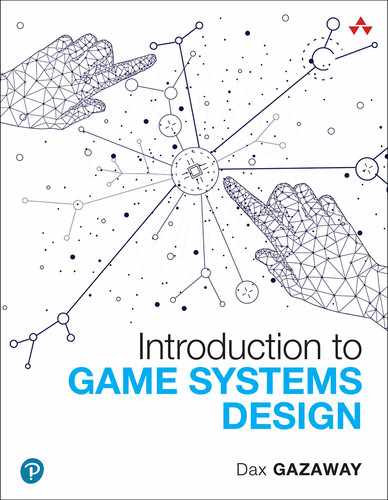As games grow more complex and gamers expectations soar, the discipline of game systems design becomes ever more important. Game systems designers plan a games rules and balance, its characters attributes, most of its data, and how its AI, weapons, and objects work and interact. Introduction to Game Systems Design is the first complete beginners guide to this crucial discipline. Writing for all aspiring game professionals, even those with absolutely no experience, leading game designer and instructor Dax Gazaway presents a step-by-step, hands-on approach to designing game systems with industry-standard tools. Drawing on his experience building AAA-level game systems (including games in the Star Wars and Marvel franchises), Gazaway covers all this, and more: Exploring the essentials of game design and its emerging subdisciplines Asking the essential questions at the heart of all design Getting started with modern game system design tools, including the spreadsheets most professionals now use Creating systems and data from a blank page Populating and quantifying a world of data into a game Tuning and balancing game systems Testing game systems and data Leveraging communication, psychology, and rewards within your games Balancing game probability within systems Whether youre a college freshman entering a game design program, an indie developer using Unreal or Unity, a Dungeon Master, or anyone who wants to really understand modern games, this guide will help you get where you want to go.
Table of Contents
- Cover Page
- About This eBook
- Halftitle Page
- Title Page
- Copyright Page
- Dedication Page
- Contents at a Glance
- Contents
- Preface
- Acknowledgments
- About the Author
- Chapter 1. Games and Players: Defined
- Chapter 2. Roles in the Game Industry
- Chapter 3. Asking Questions
- Chapter 4. System Design Tools
- Chapter 5. Spreadsheet Basics
- Chapter 6. Spreadsheet Functions
- Chapter 7. Distilling Life into Systems
- Chapter 8. Coming Up with Ideas
- Chapter 9. Attributes: Creating and Quantifying Life
- Chapter 10. Organizing Data in Spreadsheets
- Chapter 11. Attribute Numbers
- Chapter 12. System Design Foundations
- Chapter 13. Range Balancing, Data Fulcrums, and Hierarchical Design
- Chapter 14. Exponential Growth and Diminishing Returns
- Chapter 15. Analyzing Game Data
- Chapter 16. Macrosystems and Player Engagement
- Chapter 17. Fine-Tuning Balance, Testing, and Problem Solving
- Chapter 18. Systems Communication and Psychology
- Chapter 19. Probability
- Chapter 20. Next Steps
- Index
